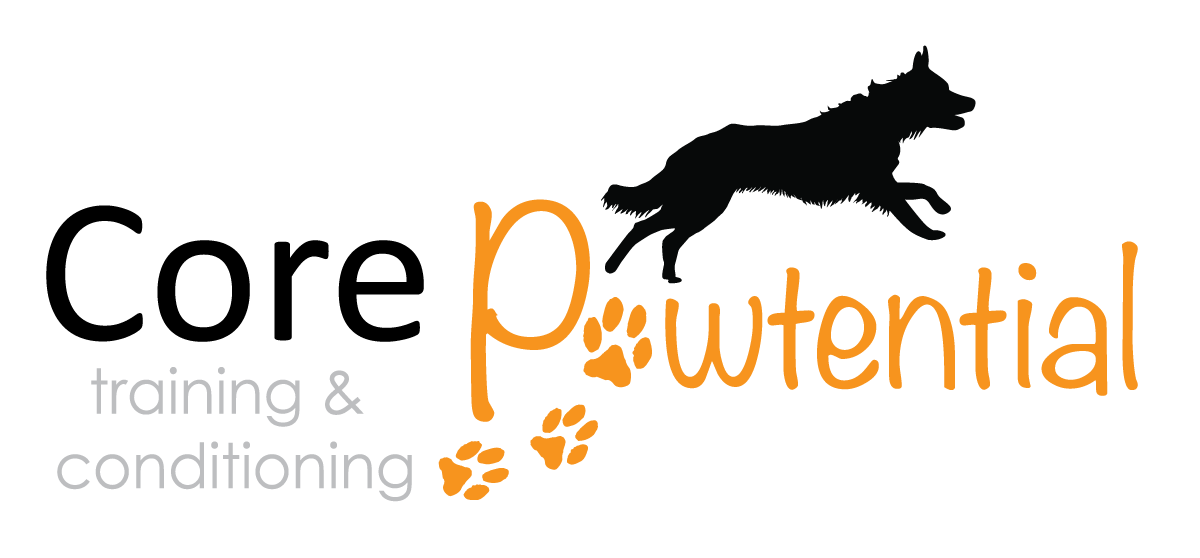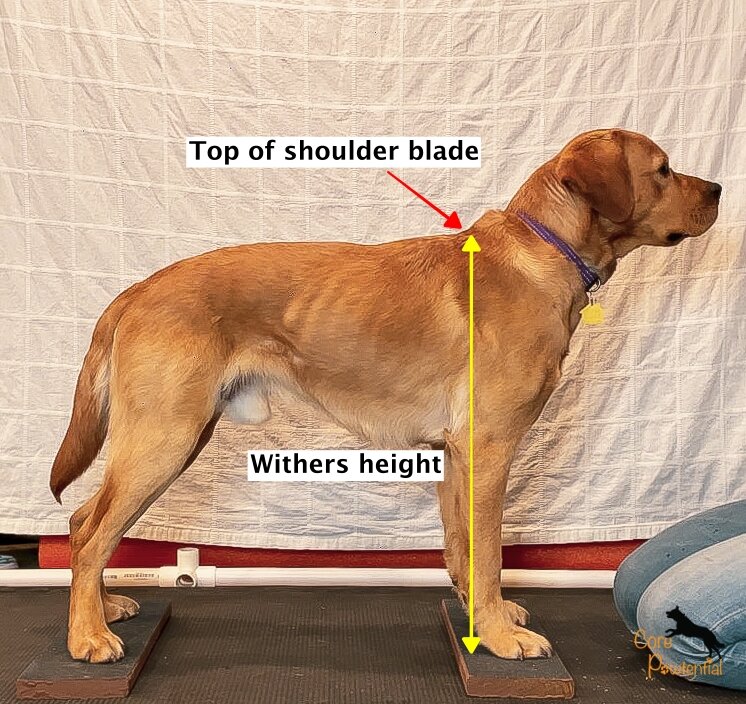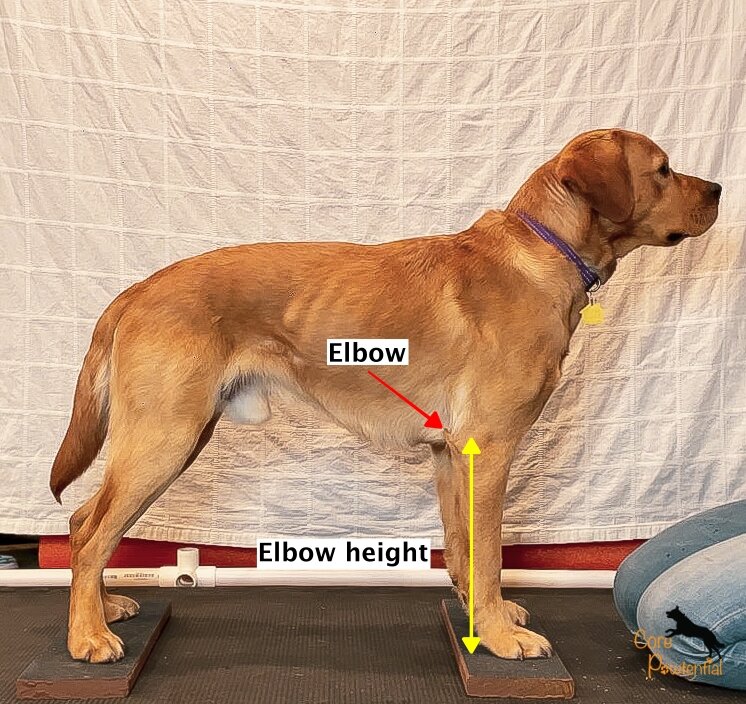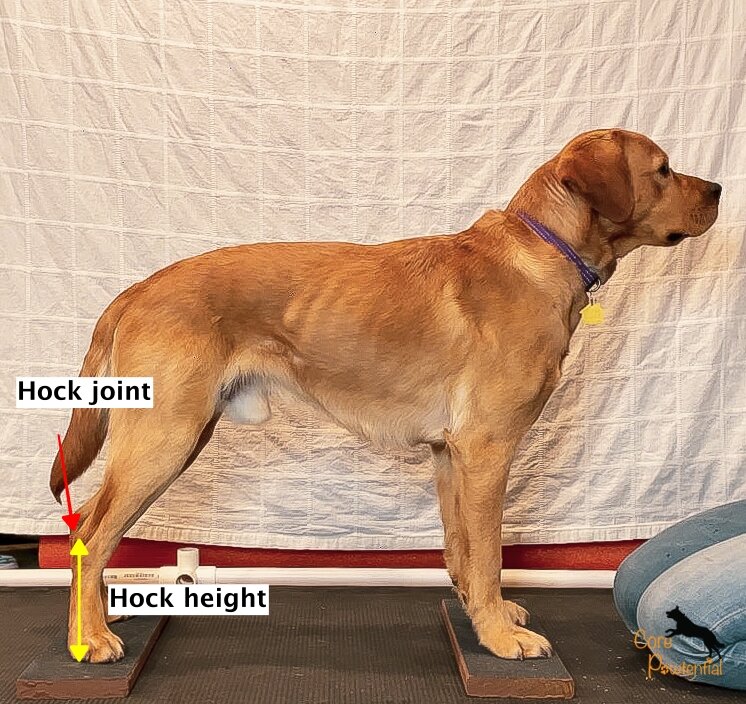Straight Cavaletti
Straight line cavaletti, as the name implies, refers to a set of cavaletti poles set in a straight line, with equal distance between poles.
This setup is the foundation of all cavaletti exercises, as it promotes body awareness, improves shoulder and hips flexibility, activates and strengthens the core muscles, and encourages focus forward.
Straight line cavaletti is designed for trotting purposes.
What you need:
- A set of cavaletti: 4-6 poles with cones/blocks (Want to make your own adjustable cavaletti?)
- A relatively flat and non-slippery surface
- A handful of yummy treats
- A dog
- Optional: Two "anchor" objects (e.g., traffic cones, rubber feeder bowls, platforms, raised beds, flat targets)
The setup:
- The distance between two poles should start at about the height of your dog’s withers (or ~2 times elbow height if you have a short-legged breed)
- For example, if the dog measures 24” at the withers, I will set the poles to be 24” apart to begin with
- If I have a Pembroke Welsh Corgi that measures 6” from the ground to the elbow, I will set the poles to be 12'“ (i.e., 6 x 2 = 12) apart to begin with
Aim for feet landing about mid-point between two poles
- Adjust the distance depending on your dog’s stride length and size
- If you hear your dog’s feet keep hitting the poles, the distance may be off and need to be adjusted
- For some dogs, you may need to shorten the distance until they learn how to maneuver across them
Start with the poles on the ground and slowly increase the height, but the height of the poles should be no higher than your dog’s hock height ( Why not higher than hock height? )
- Tip the cavaletti cones to the side can set the poles lower than the lowest hole on the cone
- When the poles are on the ground, secure them sandbags, bricks, or PVC connectors so they will not roll
The major goals:
Trot across the poles
Aim for focus forward (i.e., head looking straight)
Aim to have your dog’s feet land approximately midway between two poles (video is truly your best friend here)
Evaluating progress:
One repetition (i.e., 1 rep) refers to the dog trotting across the cavaletti setup once (e.g., trot across 5 poles set in a straight line). What is a trot?
In the beginning, reward after each rep (i.e., dog trots across cavaletti setup -> mark + reward)
Once a dog understands how to trot across the poles, focusing forward, with feet landing about mid-point between two poles, I will usually start doing 4-6 reps in a session. At this point, the dog is doing 1 set of 4-6 reps.
Slowly increase the number of reps in the set. How to increase the number of reps?
Once a dog can reliably do number of reps in 1 set, slowly increase the number of sets. I typically reduce the number of reps when increasing the number of sets to help my dogs succeed. How to increase the number of sets?
Until the dog can reliably do the increased number of reps without fatigue, I will not progress further with the exercise.
As cavaletti is a relatively repetitive exercise, I typically do no more than a total of 30 reps
Need some help tracking cavaletti progress? Download our FREE cavaletti tracker! (Printable version or Online version)
Signs of fatigue:
Panting/drooling
Knocking/kicking poles
Tripping/bumping into “anchor” objects
Unable to maintain trotting gait (e.g., jumping over poles when they could trot consistently a few reps before)
Poor form and posture (e.g., head dropping, excessive bouncing, back twisting instead of maintaining straight, limbs swinging out)
Common stress signals (e.g., scratching, yawning, sniffing, head shaking, checking out)
Beginner
Who is it for?
Start here if your dog is new to cavaletti. However, the beginner level is appropriate for dogs of all ages, including puppies and seniors, and/or dogs who need to re-learn cavaletti.
Goals
There are two main goals in the beginner level:
Learn to trot through the cavaletti independently
Maintain forward focus across 4-5 poles
Ex 2.1 >> 2 poles with anchors
Ex 2.2a >> 3 poles with anchors
Ex 2.2b >> 3 poles with bowls
Ex 2.3 >> one rep
Bonus 2.1 >> Correct distance vs. poles too far apart
Bonus 2.2 >> Correct distance vs. poles too close together
Progress checkpoint | Beginner
Is your dog able to trot through the cavaletti poles setup?
Is your dog able to focus forward (i.e., head looking forward, not looking on the ground and/or at you/other places) as they trot through the setup?
Is your dog able to have their feet land approximately mid-point between two poles most of the times?
As sometimes dogs have to adjust their stride as they approach the cavaletti setup, the landing between the 1st and 2nd pole may not be perfect. With practice, they should be able to adjust accordingly and land with their feet about midway between two poles.
Is your dog able to clear the poles (i.e., not kick/trip/knock on the poles) consistently throughout a session (e.g., 1 set of 10 reps)?
Upon watching a video of your cavaletti session, does your dog appear to trot at ease across the cavaletti setup?
Does your dog appear to move with balance and ease?
Does your dog move with relatively little bounce (i.e., up and down) of their back?
Do your dog’s legs move comfortably, or do they move in sort of a choppy way?
Is your dog able to complete your set goal of sets and reps (e.g., 1 set of 10 reps)?
Intermediate
Who is it for?
The intermediate level is appropriate for dogs who can confidently and independently trot through a set of 4-6 cavaletti poles. It is best if the dog can achieve at least 2 sets of 10 reps in one session.
Goals
The main goal in the intermediate level is to increase stamina by:
Increasing the number of reps before reward/rest
Increasing the number of cavaletti poles
while still maintaining the trotting gait with forward focus across the cavaletti
Ex 2.4 >> multiple reps with cones
Ex 2.5 >> 7 poles, one rep
Ex 2.6 >> 5 poles, increase height
Ex 2.7 >> 5 poles, low/high height comparison
Progress checkpoint | Intermediate
Consult the Progress checkpoint | Beginner, does your dog meet all the criteria for the intermediate level exercises?
Is your dog able to, consistently, complete your intended goal of Intermediate level exercises in one session?
Keep in mind that we do not necessarily transfer the intended goals from beginner level to intermediate level. The introduction of multiple reps and/or poles constitute an increase in difficulty. As we increase difficulty in one aspect (i.e., the number of reps/poles), we decrease the difficulty in other aspects (i.e., the number of sets/reps)
For example, your dog was able to complete 2 sets of 10 reps (a total of 20 reps) in Ex 2.3 (Beginner level). Your goal for Ex 2.5 (Advanced level) may be to complete 2 sets of 6 reps (a total of 12 reps).
Advanced
Who is it for?
The advanced level is for dogs who have mastered the basic and intermediate levels of straight cavaletti. Ideally, the dog can achieve 2-3 sets of 5 reps of intermediate level exercises in one session.
Goals
The main goal in the advanced level is to further improve body awareness by asking the dog to adjust stride length and height across the cavaletti, while still maintaining the trotting gait with forward focus across the cavaletti.
Notice that as I increase the difficulty of the exercise (e.g., by changing heights), I reduce the number of poles for the exercise. Keep in mind that as we increase the difficulty of one aspect (e.g., height), we lower difficulty of other aspects (e.g., number of poles, reps/sets). Only until the dog is able to achieve the same amount of fluency of ONE new challenge do we increase the difficulty of another aspect.
*It is important to note that as we adjust the height of the poles, the height of the cavaletti poles SHOULD NOT BE HIGHER THAN YOUR DOG’S HOCK HEIGHT. (Why not higher than hock height?)
Ex 2.8 >> alternate heights version 1
Bonus 2.3 >> comparison between same/alternate heights
Ex 2.9 >> alternate heights version 2
Ex 2.10 >> higher middle poles
Progress checkpoint | Advanced
Consult the Progress checkpoint | Beginner, does your dog meet all the criteria for the Advanced level exercises?
Is your dog able to, consistently, complete your intended goal of Advanced level exercises in one session?
Keep in mind that we do not necessarily transfer the intended goals from beginner level to intermediate/advanced level. The variation of height poses a challenge to the cavaletti exercise the dog is used to. As we increase difficulty in one aspect (i.e., vary the height), we decrease the difficulty in other aspects (i.e., the number of sets/reps)
For example, your dog was able to complete 2 sets of 8 reps (a total of 16 reps) in Ex 2.5 (Intermediate level). Your goal for Ex 2.8 may be to complete 2 sets of 5 reps (a total of 10 reps).
More on cavaletti









